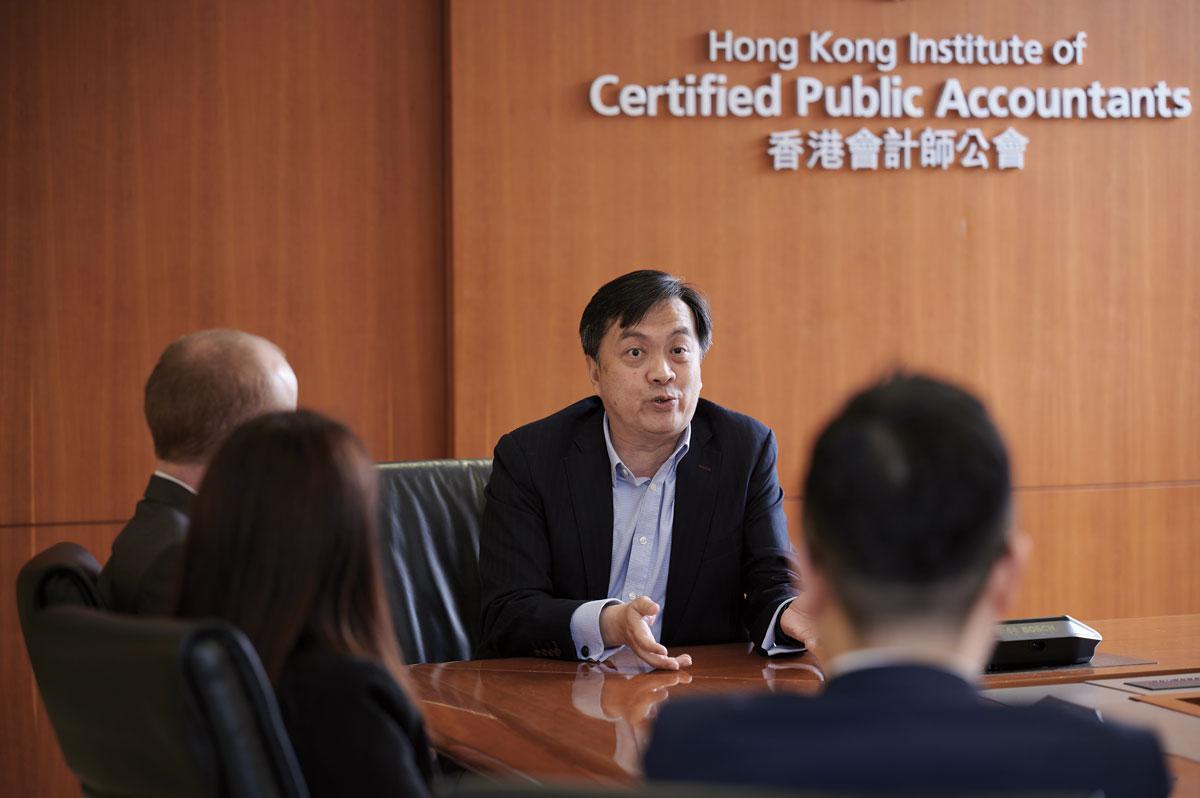Tax authorities around the world have been digitalizing their tax administration in recent years. Hong Kong’s Inland Revenue Department (IRD) shared with the Hong Kong Institute of CPAs’ Taxation Faculty in their annual meeting in 2020 that it planned to build three portals: one for individuals, one for corporates and one for tax representatives for e-filing by 2025. To discuss the technology transformation taking place in taxation, the Taxation Faculty invited seasoned tax professionals to share their insights on tax technology and transformation at a roundtable.
Speakers (from left): Doris Chik, Tax Director, National Technical Centre, Deloitte; Eugene Yeung, Partner, Corporate Tax Advisory, KPMG China; Albert Lee, Global Co-Leader and Asia Pacific Leader – Tax Technology and Transformation, EY; and Jesse Kavanagh, Partner, Hong Kong Tax Reporting & Strategy Leader, PwC Hong Kong
The changing international tax environment
Doris Chik, Tax Director, National Technical Centre and an Institute member, Deloitte, points to the cross border exchanges of information, beginning with the United States’ Foreign Account Tax Compliance Act in 2010, Country-by-Country Reporting introduced as part of the Organization for Economic Cooperation and Development’s (OECD) Base Erosion and Profit Shifting (BEPS) initiative in 2016, and the OECD’s automatic exchange of information and the Common Reporting Standard in 2017, as key drivers of change. “The tax system has become more complicated in recent years, and tax authorities need to automate the data collection process, while at the same time ensuring the integrity of the data in a cost efficient manner. Going digital is the way to go,” she says.
Eugene Yeung, Partner, Corporate Tax Advisory, KPMG China, an Institute member and a member of the Taxation Faculty Executive Committee, says that these requirements may soon see all Hong Kong corporate taxpayers being required to file annual tax returns. “Currently, inactive companies are not required to file tax returns annually. International pressure on tax systems to become more transparent means that these companies are likely to soon be required to file profits tax return annually. This will inevitably increase the workload of the IRD, and automation will be an efficient means of handling this,” he says.
Albert Lee, Global Co-Leader and Asia Pacific Leader – Tax Technology and Transformation, EY, sees tax authorities around the world adopting e-filing, with more and more collecting data through an internationally agreed format called XBRL. Standing for “eXtensible Business Reporting Language,” the global framework provides consistency and, hence, enables the exchange of business information between jurisdictions. “For taxpayers, the key will be to capture the source data correctly, so that generating XBRL files can be automated and cost efficient,” he says.
Lee also mentioned that there is a trend to make e-filing mandatory or virtually mandatory. Japan has made e-filing for corporations compulsory and similar requirements are also found in the United Kingdom and Singapore. Hong Kong has begun to catch up with its digital transformation.
Improving tax authority operations
Jesse Kavanagh, Partner, Hong Kong Tax Reporting & Strategy Leader, PwC Hong Kong, points to the benefits technology can provide. “With the wealth of data captured by electronic tax systems, tax authorities can use data analytics for tax audit case selection,” he says.
Yeung agrees, noting that by using robotic process automation technologies, work efficiency can improve, and humans can focus on the processes that require judgement.
For tax authorities, the drive to go digital can also mean some of the work of the department can be outsourced to data providers. Lee highlights some recent discussions he has had with another tax authority in the region. “I was told that their digital strategy was to leverage other stakeholders, by having the financial institutions, the tax and accounting software companies, and tax agents representatives help execute their digital strategy,” he says.
The experience of COVID-19 has also pushed tax authorities around the world to digitalize. In Hong Kong, civil servants from the IRD were working at home, which hindered their productivity, points out Yeung. Digitalizing the tax process, while also ensuring it remains secure, enables staff to work remotely. “COVID-19 has shown that systems have not been up to scratch,” agrees Kavanagh.
For taxpayers, an electronic filing system can improve the filing experience, but only if implemented well. “Tax authorities should ensure that the e-filing system collects only the absolutely necessary data,” says Lee. Kavanagh points out that an overcomplicated or demanding system can lead to a decrease in information collected. “The IRD’s recent request for transfer pricing information is a good example of this. The department asked for more information than is contained in the 3-tier documentation requirements, and some taxpayers, particularly those that are local subsidiaries, have real difficulty in gathering this information, leading to difficulties in complying with the requirements,” he says.
Tax authorities should try and minimize the work of taxpayers says Chik. “Pre-populated returns, where taxpayers filing returns are only required to check the pre-filled parts are correct and enter new information, improves the efficiency of the system and improves the user experience,” she says.
The simplicity of the rules is important for enabling a greater share of the work to be automated advises Yeung. “A possible strategy that some jurisdictions may take is to make use of the opportunity created by digital filing to review and simplify their tax codes. Simplification also decreases the number of elections, unusual items and other elements of tax that are outside the ability of pre-population systems.” This will improve the systems effectiveness and accuracy, he notes.
Lee gives the example of the U.K.’s Her Majesty’s Revenue and Customs experience as an early adopter of XBRL and inline XBRL (iXBRL), a version of the framework focused on the electronic rendering of financial information encoded in an XBRL document. “They worked with the registrar of companies, Companies House, to do joint filings for both tax returns and annual filing of company accounts, which makes the system more efficient,” he says.
“With the wealth of data captured by electronic tax systems, tax authorities can use data analytics for tax audit case selection.”
Transforming the legal regime
The digital transformation of tax filings cannot be completed without the transformation of the tax authority, infrastructure, approach and laws. “Due to confidentiality requirements under the Inland Revenue Ordinance (IRO), the IRD has been very cautious about information exchanges with other government departments. If it is a policy intention to enhance information exchanges, corresponding changes to the IRO may be required,” Lee notes.
Changing the IRO is an important part of the technology transformation. “Without a proper legal basis for the requirements for data to be supplied in a given format, such as filing electronically, taxpayers will lack the certainty they need to plan their compliance activities and may be unwilling to comply with the tax authorities requests,” says Chik. “A thorough mapping of all existing legislation is required so that all issues can be identified,” she continues.
Increasing the responsibilities of tax representatives
Chik points out that the IRD is considering penalties for service providers including tax representatives who file electronic returns on behalf of their clients. “On the assumption that there is no change in the work nature and service scope of the tax representatives for e-filing, the potential introduction of penalties in the IRO would be unreasonable. E-filing should be seen just as a different mode of delivery of returns, comparable to the traditional paper-based filings,” she says.
While the taxpayer experience can be enhanced by the use of technologies, tax authorities should try to limit the burden on tax representatives. “If tax representatives are required to certify all information uploaded to e-filing systems, the cost of tax services will increase,” says Kavanagh. He notes that service providers have traditionally not been offering an assurance service on data.
Lee notes that challenges due to Hong Kong’s adversarial system needs to be overcome. “The IRD needs to collaborate with taxpayers and tax representatives. The IRD needs to introduce incentives to encourage e-filing,” he says.
Involving stakeholders in the changes
Ahead of any new systems being introduced, the IRD will consult stakeholders, including taxpayers and tax representatives, to explain the changes and the new workflow, and ensure that when the systems are released there are no issues. The timely announcement of details also provides service providers with sufficient time to upgrade their proprietary software to cope with new filing requirements.
“Ongoing consultation is important,” says Chik. “Just like the recent soft consultation, we were glad to learn through a question and answer session with the IRD organized by the Taxation Faculty that the IRD intends for the status quo to continue, allowing tax representatives to prepare tax computations by using their proprietary software. The tax representatives may only need to use free-of-charge software to be provided by the IRD to convert the files into iXBRL data files for filing.”
Though the Hong Kong tax system is simple, tax computations for certain companies can be complicated she notes. “For instance, apportionment for partial offshore claims. We need to find out means to deal with converting these more complex tax computations into the designated format going forward,” Chik continues.
For Yeung, the expectations of what’s possible need to be managed. “It is unrealistic to expect that we can automate everything. Perhaps an 80:20 rule applies where 80 percent of taxpayers would go for the virtually mandatory e-filing. Whereas, 20 percent – the digitally excluded population – continue to file paper based returns.
Lee advises the IRD to collaborate more with stakeholders in its planning and implementation of the digital transformation programme. “In Singapore, the tax authority asked the Big Four firms, with relatively more resources, to pilot e-filing,” he says. By working with software vendors, he advises, the IRD can ensure that the essential features needed are incorporated into the off-the-shelf software used by taxpayers, increasing the efficiency of the rollout of the e-filing platform.
Preparing taxpayers
The traditional methods used by corporate tax functions may not be capable of answering some of the questions raised by tax authorities’ systems. Taxpayers may therefore need to update their systems to enable their e-filing. Chik notes that many taxpayers have completed or are in the process of digitalizing their systems – including the tax functions – because of the long-term benefits it can bring to their operations through cost savings and other efficiencies.
Mirroring tax authorities, where e-filing is the beginning of the process, for corporates the filing is the final stage of their financial reporting processes. In order to enable e-filing, and the filing of the underlying data, corporates must ensure their entire data collection, analysis, and reporting processes are capable of the tasks, and should utilize systems to enable such data transformations. Taxpayers may require support and guidance to change their systems.
“We are observing a shift away from standalone tax systems in favour of leveraging existing enterprise systems, such as enterprise resource planning (ERP) systems. The beauty of having just one single system that caters to both the financial accounting and tax needs is that we can have a single source of truth,” says Lee.
He notes that in the past year, enterprises have been less willing to invest heavily in updating theirERP systems because of COVID-19 disruptions. “Instead, they have been investing in enterprise performance management or corporate performance management systems typically used by finance departments for consolidations, performance management and analysis,” he says.
Kavanagh says that tax technology transformation is a workflow enabler for businesses, particularly multinational enterprises. “A capable tax technology system gives you the comfort that the tax processes are done properly in different geographical locations,” he advises.
For Yeung, the increasing demands from tax authorities are an important driver to change. “Transfer pricing compliance is becoming more demanding. The ability to produce reasonable value attribution analysis based on the functions, assets and risks of local entities is helpful for avoiding audits,” he says. If a system can capture all the data, it can be easier to conduct transfer pricing modelling, and identify and fix problems speedily, he says. Lee agrees, seeing transfer pricing as a low hanging fruit ripe for improvement with tax technology.
The coming BEPS 2.0 initiative will further increase the importance for multinational corporations (MNCs) to model the allocation of profits to entities in different jurisdictions, advises Yeung. Kavanagh points out that this will require MNCs to manage their risks and opportunities between jurisdictions. Moreover, Lee thinks that the Pillar Two Global Anti-Base Erosion proposal of minimum tax rates could be integrated with tax reporting processes.
Change must be led from the top, Chik says. “Having a senior enough person within the organization as the sponsor of the technology transformation increases the chance of success.”
“We are observing a shift away from standalone tax systems in favour of leveraging existing enterprise systems, such as enterprise resource planning systems.”
What are the impacts of digitalizing turnover taxes?
Brazil and China have digitalized their turnover tax collection. In Brazil, an extensive system of mandatory e-invoicing has helped to reduce undeclared sales and complex carousel frauds, where value-added tax (VAT) free goods are imported, sold with VAT paid, but not paying the VAT to the government. Sales and purchases are now submitted in real time to the tax authority, allowing for the detection of sales tax fraud.
In Mainland China, the State Taxation Administration has embarked on a series of tax digitalization projects since 1994, under the banner “Golden Tax Project.” The current stage, “Golden Tax Project Phase 3,” is focused on harmonizing tax compliance processes and unifying the processes used in each province, including a partial e-invoicing system.
For Jesse Kavanagh, Partner, Hong Kong Tax Reporting & Strategy Leader, PwC Hong Kong, such a system is a game changer. “With real time data from the e-invoicing system, tax authorities can issue turnover tax assessments straight away,” he says.
Efficiency can be improved with digitalization, advises Albert Lee, Global Co-Leader and Asia Pacific Leader – Tax Technology and Transformation, EY. “However, not many jurisdictions have implemented e-invoicing and systems that are capable of automatic assessment systems for turnover taxes,” he says.
Digitalization can also reduce fraud according to Doris Chik, Tax Director, National Technical Centre, Deloitte. “With the introduction of the e-invoicing system and better VAT invoice authentication, the risk of fake invoice fraud and tax leakage is significantly lower,” she says.
Becoming a tax professional
For those interested in advising businesses on their tax matters, the panellists have the following advice.
“You have to have a broad skill set rather than just focusing on the technical,” says Jesse Kavanagh, Partner, Hong Kong Tax Reporting & Strategy Leader, PwC Hong Kong. “You may be asked to do something unexpected, so you must be open-minded, and prepared to embrace change and new technologies.”
The ability to understand technology and problem solve is as important as an accounting background, says Albert Lee, Global Co-Leader and Asia Pacific Leader – Tax Technology and Transformation, EY. “With tax authorities going more digital, tax professionals need to adapt – the challenges are no longer just about the law or accounting,” he says.
Eugene Yeung, Partner, Corproate Tax Advisory, KPMG China and member of the Institute’s Taxation Faculty Executive Committee, says that mentality is the most important consideration for his firm when hiring. “Data is a key element of the process, but technology can be implanted in a ‘non-rocket science’ way,” he says. It is, in fact, important for professionals to be able to think through changes and make recommendations.
Tax is a continually transforming specialization, advises Doris Chik, Tax Director, National Technical Centre, Deloitte. “An openness to continuing training and development, and good communication skills are important for tax professionals,” she says.


















